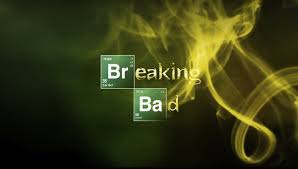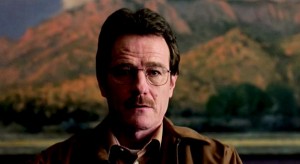The Pathos of Breaking Bad (Part 1)
By Asher Crispe: February 13, 2014: Category Inspirations, Quilt of Translations
“If you want to use television to teach somebody, you must first teach them how to use television.”
―Umberto Eco
 While television culture rarely presses the pause button long enough to entertain the implications of what we see, when we are hit with a show of Shakespearian proportions that has universally been acclaimed as a masterpiece of filmic art it warrants some serious reflection and perhaps a conversation or two. For our purposes, we are going to experiment with the chemical reactions that occur when you starting mixing Jewish mysticism with the anti-heroic narrative of Walter White, A.K.A. Heisenberg, the central figure of the hit television series, Breaking Bad.
While television culture rarely presses the pause button long enough to entertain the implications of what we see, when we are hit with a show of Shakespearian proportions that has universally been acclaimed as a masterpiece of filmic art it warrants some serious reflection and perhaps a conversation or two. For our purposes, we are going to experiment with the chemical reactions that occur when you starting mixing Jewish mysticism with the anti-heroic narrative of Walter White, A.K.A. Heisenberg, the central figure of the hit television series, Breaking Bad.
The major question before us is how could ‘one of us’–a straight-laced, ordinary, law abiding citizen–slowly morph into a ruthless drug kingpin and murderer? Do we really have that many degrees of freedom? This is a story that captures the process of getting ‘there’ from ‘here’–as improbable as that may seem.
First let’s point our guns at the title of the show: Breaking Bad. What do these words have to do with anything remotely mystical? Is it the story of how we can fall if we are not careful? Does it uncover something earth-shaking about the existence of evil? Why ‘bad’? Why ‘breaking’? Could these two words have some kind of esoteric association?
Let us propose to inquire after both the breaking down of the bad–its analysis and potential conversion into something good (we would kill the cancer and have it expelled from the body if only we could understand it first) and the breaking of the self (along with its relationship to the good and to others) that defines the bad itself. The ‘transgressive’ experience which oversteps functional boundaries or indulges in egotistic excesses violates any constitution of wholeness. We feel ourselves to be incomplete. Something is missing. When we confide that ‘I’ am going to pieces, we are testifying to a strange absence, a sense of antagonizing loss. Our diagnosis of the ‘bad’ walks over the fragments and shrapnel of broken containers. Ironically the only remedy for the broken is to become further broken–to break the breaking.
While one might think to reach for glue in a last ditch effort to reassemble the Humpty Dumpty we have become–to get our lives back together–it is never quite so simple and direct. ‘Picking up the pieces’ may have to wait until the pieces are sufficiently small and humbled so as to willingly and freely go back together. Running through the procedure once more: if the bad is evidenced by breaking, then the break from the bad paradoxically requires a further break.
How does Kabbalah explain the existence of evil?
In the primordial universe there were massive lights which were placed within immature vessels. Being too small for the lights the vessels broke, releasing the lights which withdrew as the fragments of the vessels fell below into the lower worlds. Redemption is conceived as the ingathering of the exiled ‘sparks’ or shards of the broken vessels which may some day come to form properly rectified vessels with the assistance of additional outside input. The inadequacy of the initial vessels proved to be the critical failure in the system. The lights immediately overpowered them and, not being able to maintain proper containment so as to express the lights, resulted in their own short circuiting.
Now for the psychological translation which takes us out of the business of electrical engineering: lights are often emblematic of ‘experiences.’ If I have a profound inner subjective experience it can be compared to an enormous light shining within me. Since most people are familiar with the popular notion of a ‘light in the attic’ as an ‘idea in the back of one’s mind which suddenly pops on, we can start there. If the abstract and relatively disembodied experience of an idea flashing across the screen of my mind is a pure light in and of itself, then my attempts at communicating that idea require me to search for a fitting vehicle wherein I may deposit that idea and shuttle it across the Grand Canyon that separates me from you. What I need is a vessel–something to pour my idea into, something that you can grasp. In this case, that vessel or vehicle is speech. I have to struggle to find the right words to convey my ideas.
For the average everyday stuff, ordinary words suffice. Nothing blows up when I say ‘I am hungry, please pass the chicken.’ Yet, those ideas harvested from the core of my being, from my essential self—the thoughts that I believe define me as me unto which I cling to—those enlightened ideas are the most difficult to pass along. Most of us have run into this problem at one time or another. These colossal ideas just don’t fit into words. When we speak them our utterances reveal how over-stuffed and fragile they are. We cherish the words and in doing so become overly self-conscious of their shortcomings. Instead of passing along meaning we fumble the ‘proverbial’ football. Signification bleeds out all over the place. The soul of speech as the idea which illuminates it floats away and the mechanical parts of language seem to have been left for us as if after a grave robbery. There are little or no remains to exhume. Only traces of the personality of the idea can be found if we dig carefully.
This is a basic translation of the breaking of the vessels. When one compares the poverty of words to the big things that one wishes to say, the fragmentation is the introduction of information entropy. It is the noise drowning out the signal. Since the Torah maintains that all of reality is constructed out of language, our broken world is a result of the breaking of these primordial vessels–a far reaching miscommunication. Rather than thinking of this cosmologically as a one time event located in some immemorial past, Chassidic thought pulls this description into the continuous present. It represents the primacy of our life experience burdened with the uncertainty as to how we can share it with others. Losing control of the ‘meaning’ we are laboring to impart, we fall victim to misdirection and struggle with unintended consequences.
If only we could resurrect our original intentions and reassemble our vessels and vehicles with improvements made, then perhaps the very category of the ‘bad’ would dissolve. Bigger and better containers might come from choosing better words but it could also manifest via multiplying the number of words. This is as if to say: ‘in case you didn’t get me the first time, let me say it over in a few different ways.’ Hopefully, one of these diverse modes of address will strike gold. Package received. No need for glue. It’s all intact. And ideally the wrapping gives away what is inside. The container takes on the appearance of the contained, or to use the original kabbalistic terminology, the vessel is just a concentrated form of the light itself.
In the interim, it is this shattering which addresses the existence of evil. According to Kabbalah, all evil points back to the breaking of the vessels (shevirat ha’kelim) which allowed for things to ‘break bad.’ For Walter White this breaking began with the antagonism between his expectations as to where his life should have been (at the helm of a super successive company which he cofounded until he was pushed out by his friends and partners) and where he wound up (struggling to provide for his family as an ordinary high-school chemistry teacher with no acknowledgment of his true genius). His entire life story was one big, broken vessel. His biography didn’t read like he thought it would. His resumé did not ‘contain’ him–the real Walter White brimming with astonishing erudition. The science maverick had turned tail and fallen in line with the rest of the herd. He had tried to approach the sun and got his wing burnt so he chose early retirement in Pleasantville with a small but consistent paycheck.
 Throughout the five seasons of the show we learn how this particular volcano of resentment was not extinct but just idling in dormancy only to awaken with a full-blown eruption. His magma becoming lava, our protagonist consumed first himself and then everything else around him. The building up of internal pressures within Walt underscore just how ill suited he was to his current life. He clearly had to act. However, change has a way of breaking what it is changing, especially when so much emotional heat and combustible desire are simmering under the surface. Unlike those libertines who argue that resistance is futile, the Torah focuses on how we are both blessed and encumbered with an immensely powerful animal soul which we must strive to keep in check. This intense, unbridled energy needs to be channeled, otherwise it will be a force of mass destruction. Herein lies the stumbling block for Walter White. Once he lets the cat out of the bag there is no telling where it might take him. Such creatures have a habit of running away on their own.
Throughout the five seasons of the show we learn how this particular volcano of resentment was not extinct but just idling in dormancy only to awaken with a full-blown eruption. His magma becoming lava, our protagonist consumed first himself and then everything else around him. The building up of internal pressures within Walt underscore just how ill suited he was to his current life. He clearly had to act. However, change has a way of breaking what it is changing, especially when so much emotional heat and combustible desire are simmering under the surface. Unlike those libertines who argue that resistance is futile, the Torah focuses on how we are both blessed and encumbered with an immensely powerful animal soul which we must strive to keep in check. This intense, unbridled energy needs to be channeled, otherwise it will be a force of mass destruction. Herein lies the stumbling block for Walter White. Once he lets the cat out of the bag there is no telling where it might take him. Such creatures have a habit of running away on their own.
In Part Two we will examine more closely the chain reaction of events in Breaking Bad that magnify a person’s potential to lose control.
The Pathos of Breaking Bad (Part 1),



















;)
;)
;)
;)
;)
;)
;)
;)
;)
;)

Fantastic.
Yasher koach/congrats/kudos on writing this four-part essay on the Shakespearean show, Breaking Bad.
Being an observant Jew, I hardly had anyone to discuss this show with in my shul. I actually read it today between mincha and maariv:-)
I am pleasantly surprised and greatly pleased that Rabbi Crispe not only watched it, but broke it down according to the teachings of Kabbalah & Chassidus.
Awesome!
So glad that a fellow Breaking Bad enthusiast enjoyed the series!! Thank you!! Asher